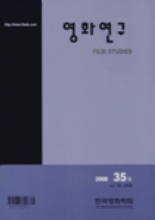- 영문명
- A Study on Bordwell's Narrative Approach: Syuzhet Analysis to Antonia's Line
- 발행기관
- 한국영화학회
- 저자명
- 문미원
- 간행물 정보
- 『영화연구』제35호, 135~169쪽, 전체 35쪽
- 주제분류
- 예술체육 > 예술일반
- 파일형태
- 발행일자
- 2008.03.31

국문 초록
영문 초록
This article analyzes Antonia's Line, using V. Propp’s‘ morphology of folk tail, C. Levi-Strauss’‘structural narrative’, Russian Formalism, and D. Bordwell’s ‘neo-formalism’ as background theories. Different from other existing articles, the frame of narrative theory of D. Bordwell is used for analysis in this article. I used the narrative approach instead of feministic approach because in the cinema analysis, narrative analysis is a fundamental research tool and moreover, narrative theory should precede any other theories or cinema analysis. As a result of syuzhet analysis for Antonia's Line's, I found that this cinema has a narrative structure of ‘art cinema’. Controlled by art cinema’s objective reality, uncertainty and ambiguousness, there is no clear storyline in this cinema. Art cinema narrative has an expressive realism, and it expresses a depth of character's subjective mentality. As an art cinema, Antonia’s Line has some perceptive scenes that express the heroin’s subjective psychology. On the basis of European modernism, Antonia's Line has scenes that respect nature. The director describes meaningful figure of life in the cinema. Especially, the lunch scene in the garden depicts the life of matrilineal community, and act as a channel of accepting new members. The lunch scene means pulling down the ideology of patriarchal system, and returning to a matrilineal society. Form and style of the cinema interact together and set up the story. Viewers make their own 'skimata' at the cinema's 'fabula'. In the cinema, patriarchal system and matrilineal society, Catholic and anti-Catholic build principal axes. Letha, Didi, Loony lips, Olga and assistant priest are friendly characters to Antonia’s, while Dan, Peter represent an axis of patriarchy system, and hypocrite Catholic priest represents another axis of Catholic. In many scenes, Antonia's Line expresses uncomfortable feeling against Catholic. ‘To be strange', which is one of the techniques of 'syuzhet', is a basic principal of narrative composition in this cinema. Fantasy scene that connects time and space of the present and the past, moves form Daniella's eyes to Sara's eyes. This scene shows that Sara becomes central figure in Antonia's Line. From this scene, director asks viewers to have distance from the story itself and get some more objective point of view. Whenever problem occurs, Antonia reasonably solves them and adapts her life to nature. In that sense, I'm resists this is not an anti-patriarchism cinema, it is an alternative cinema that leads us to have new points of view. It is clear that Antonia's Line is a substitution for patriarchy system. This shows an alternative family system and ideology in the new value system.
목차
1. 들어가는 글
2. 이론적 논의
3. 본론
4. 결론 및 논의
해당간행물 수록 논문
참고문헌
최근 이용한 논문
교보eBook 첫 방문을 환영 합니다!

신규가입 혜택 지급이 완료 되었습니다.
바로 사용 가능한 교보e캐시 1,000원 (유효기간 7일)
지금 바로 교보eBook의 다양한 콘텐츠를 이용해 보세요!


